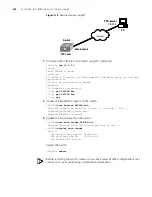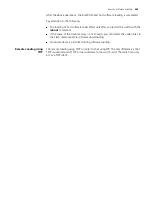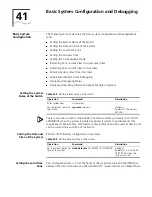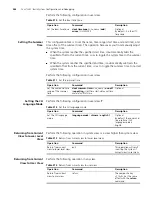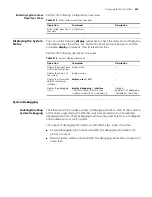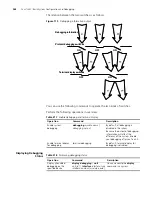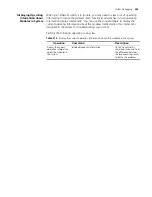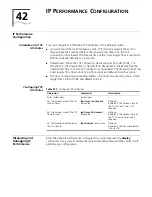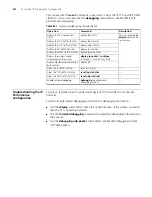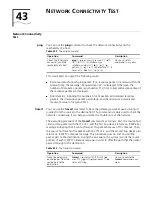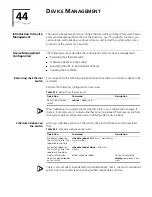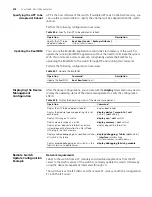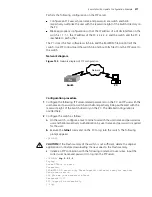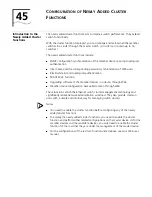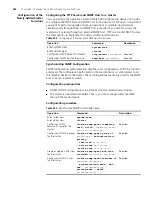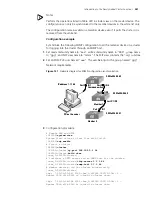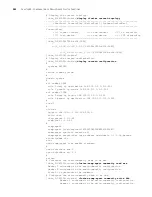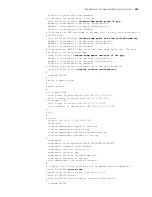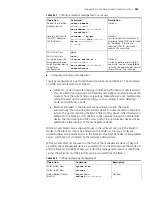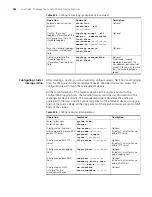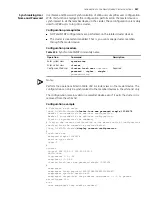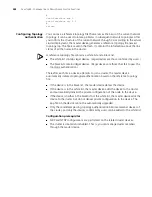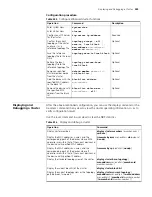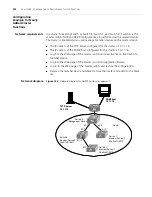
376
C
HAPTER
44: D
EVICE
M
ANAGEMENT
Specifying the APP to be
Adopted at Reboot
APP is the host software of the switch. If multiple APPs exist in the Flash memory, you
can use the command here to specify the one that will be adopted when the switch
reboots.
Perform the following configuration in user view:
Updating the BootROM
You can use the BootROM application saved in the Flash memory of the switch to
update the running BootROM application without the need to terminate the system.
With this command, a remote user can conveniently update the BootRom by
uploading the BootROM to the switch through FTP and running this command.
Perform the following configuration in user view:
Displaying the Device
Management
Configuration
After the above configurations, you can execute the
display
command in any view to
display the operating status of the device management to verify the configuration
effects.
Remote Switch
Update Configuration
Example
Network requirements
Telnet to the switch from a PC remotely and download applications from the FTP
server to the Flash memory of the switch to remotely update the switch software by
using the device management commands through CLI.
The switch acts as the FTP client, and the remote PC serves as both the configuration
PC and the FTP server.
Table 326
Specify the APP to be adopted at reboot
Operation
Command
Description
Specify the APP to be
adopted at reboot
boot boot-loader
[
backup-attribute ]
{
file-url
|
device-name
}
—
Table 327
Update the BootROM
Operation
Command
Description
Update the BootROM
boot bootrom
file
-
url
—
Table 328
Display the operating status of the device management
Operation
Command
Display the APP to be adopted at reboot.
display boot-loader
Display the module type and operating status of
each board.
display device [ manuinfo [ unit
unit-id ]
| unit
unit-id
]
Display CPU usage of a switch
display cpu
[
unit
unit-id ]
Display memory usage of a switch
display memory
[
unit
unit-id ]
Display system diagnostic information or save
system diagnostic information to a file suffixed
with diag in the Flash memory
display diagnostic-information
Display enabled debugging on a specified switch or
all switch in the fabric
display debugging
{
fabric
|
unit
unit-id
}
[
interface
interface-type
interface-number
|
module-name
]
Display enabled debugging on all switches in the
fabric in terms of module names.
display debugging
fabric
by-module
Summary of Contents for 4200G 12-Port
Page 10: ...8 CONTENTS...
Page 14: ...4 ABOUT THIS GUIDE...
Page 46: ...32 CHAPTER 5 LOGGING IN THROUGH WEB BASED NETWORK MANAGEMENT SYSTEM...
Page 48: ...34 CHAPTER 6 LOGGING IN THROUGH NMS...
Page 60: ...46 CHAPTER 9 VLAN CONFIGURATION...
Page 64: ...50 CHAPTER 10 MANAGEMENT VLAN CONFIGURATION...
Page 80: ...66 CHAPTER 13 GVRP CONFIGURATION...
Page 98: ...84 CHAPTER 15 LINK AGGREGATION CONFIGURATION...
Page 112: ...98 CHAPTER 18 MAC ADDRESS TABLE MANAGEMENT...
Page 126: ...112 CHAPTER 19 LOGGING IN THROUGH TELNET...
Page 162: ...148 CHAPTER 20 MSTP CONFIGURATION...
Page 274: ...260 CHAPTER 29 IGMP SNOOPING CONFIGURATION...
Page 276: ...262 CHAPTER 30 ROUTING PORT JOIN TO MULTICAST GROUP CONFIGURATION...
Page 298: ...284 CHAPTER 33 SNMP CONFIGURATION...
Page 304: ...290 CHAPTER 34 RMON CONFIGURATION...
Page 338: ...324 CHAPTER 36 SSH TERMINAL SERVICES...
Page 356: ...342 CHAPTER 38 FTP AND TFTP CONFIGURATION...
Page 365: ...Information Center Configuration Example 351 S4200G terminal logging...
Page 366: ...352 CHAPTER 39 INFORMATION CENTER...
Page 378: ...364 CHAPTER 40 BOOTROM AND HOST SOFTWARE LOADING...
Page 384: ...370 CHAPTER 41 Basic System Configuration and Debugging...
Page 388: ...374 CHAPTER 43 NETWORK CONNECTIVITY TEST...
Page 406: ...392 CHAPTER 45 CONFIGURATION OF NEWLY ADDED CLUSTER FUNCTIONS...

